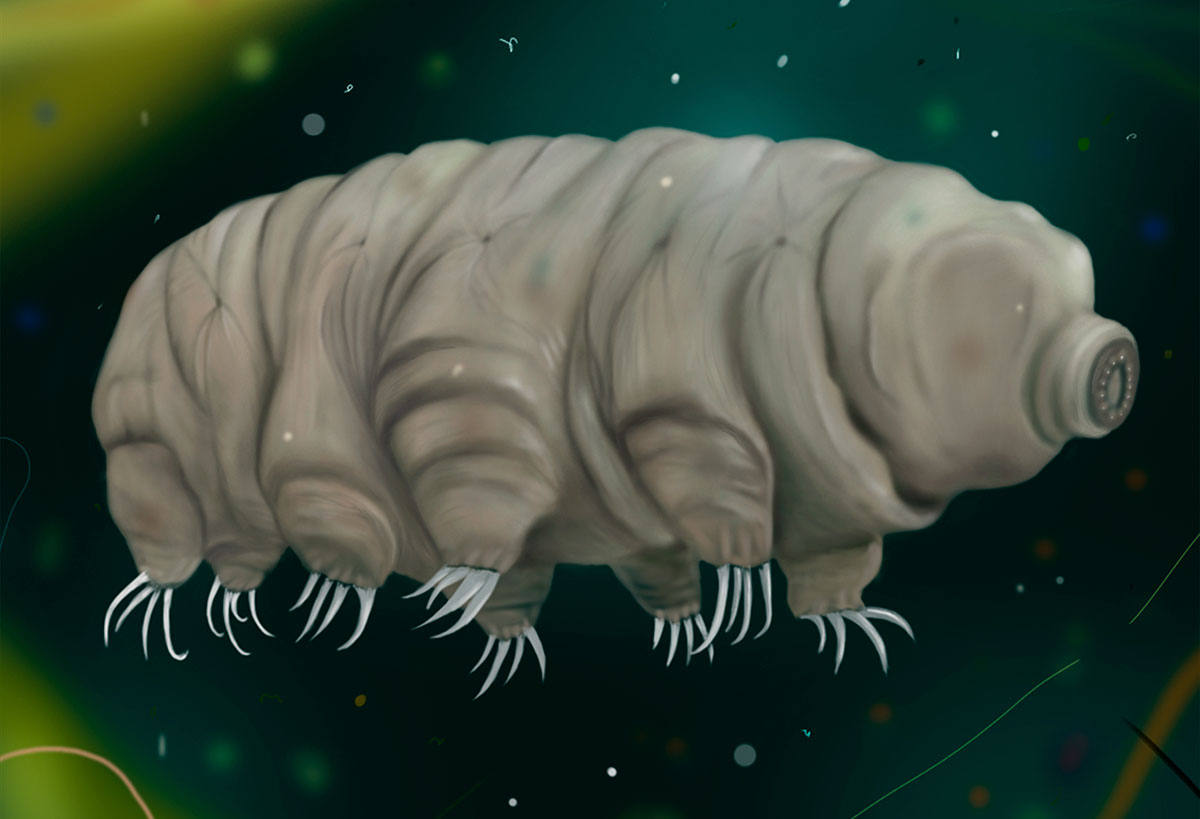
Only about .02 inches big (half the size of the tip of a pencil point or ¼ the width of a nickel), the tardigrade is a microscopic invertebrate that looks like something out of a science fiction movie. Most closely related to insects and crustaceans, tardigrades have 8 legs but look more like the horizontal version of the Stay-Puft Marshmallow Man than any bug or crab.
The scientist who discovered them, Johann August Ephraim Goeze, first named them kleiner Wasserbär. His native German translates to “little water bear.”
While we can’t deny that tardigrades are known to live in aquatic environments, the jury’s still out on the cute pseudonym many researchers still give them. Their scientific name comes from tardigradum which is latin for “slow walker” which is undeniably true.
Tardigrades Can Live Anywhere
Tardigrades live almost anywhere, though they prefer moist environments. The types of situations tardigrades can survive in lead to many presumptions of their indestructability.
While it is true that they can exist in some extreme circumstances – in harsh high and low temperatures, in acute high and low pressures; through dehydration, air deprivation, radiation, and starvation, to name a few – it doesn’t mean they actively live through these situations.
Tardigrades Can Hibernate
Tardigrades enter a state of stasis called the tun state in which they dry out their body and enter a sort of hibernation.
They can remain in this stasis for decades, coming out of it 30 years later as if it were simply a power nap.
Researchers have found that the tardigrade can outlive mankind. They have existed since the Cetaceous period and scientists believe that they could survive any future catastrophic events that would make life on planet Earth impossible for most other species. Come dinosaur-ending asteroid or supernova, the tardigrade would most likely live on.
While they have circulatory, digestive, and nervous systems, tardigrades have no respiratory organs, suggesting that these little slow-walkers breathe via a gas exchange across their whole body. Whether or not this helps them in extreme circumstances, it can not be denied that they are exceedingly resilient. The technical term is extremophile.
Tardigrades In Space
In 2007, scientists shot a team into orbit and submitted them to the vacuum of space. Don’t worry, these weren’t human test subjects. It was a squad of hardy tardigrades who proved they could exist in not only the sub-zero temperatures of space, but through all of the uncomfortable and unforgiving elements of it – dehydration, freezing, radiation, and weightlessness, to name a few. On the descent back to Earth, these extremophiles even managed to reproduce.
One way they managed to survive was by replacing the water in the body with trehalose, a sugar that helped them avoid the adverse effects of space. Ingemar Jonsson who launched (literally) this experiment says you could even put a tardigrade into pure alcohol or poisonous gas and they wouldn’t die.
They can die, though. In the space experiment, Jonsson found that the dire circumstances of outer space mixed with high UV exposure was too much for the tardigrades. The radiation got the better of them. But, some survived. A minority, in comparison to those that didn’t, but some nonetheless.
This makes them the only animal living on Earth proven to survive completely unshielded to astral elements. Scientists hypothesize that tardigrades help explain how life was possible on Mars or even as far as the moons of Jupiter and Saturn.
In everyday life, however, tardigrades are relatively short-lived creatures. Their average life span is only 3 to 4 months, depending on the species. Their tun state can prolong some species’ lives up to 12 years, though as we said, they aren’t really living during that biological hibernation.
Their awe-inspiring resilience does not make them totally indestructible, however. The most efficient way to kill a tardigrade? Squish it.
Sources:
https://en.wikipedia.org/wiki/Tardigrade#:~:text=Tardigrades%20(%2F%CB%88t%C9%91%CB%90rd,called%20them%20little%20water%20bears.
https://www.nationalgeographic.com/animals/invertebrates/t/tardigrades-water-bears/
https://www.livescience.com/57985-tardigrade-facts.html
https://www.britannica.com/animal/tardigrade
https://digitalcommons.mtu.edu/cgi/viewcontent.cgi?article=1083&context=bryo-ecol-subchapters

Çok başarılı bir anlatım olmuş teşekkür ediyoruz böyle sade ve anlaşılır bir dille paylaştığınız için; SaygılarımlaDüşen Domainler
Resep Mudahbun
Resep Mudahbun
Kripto para indikatörü bu para piyasasında yatırım yapmak ve para kazanmak isteyen kişilerin, takip etmesi gereken analizlerdir.